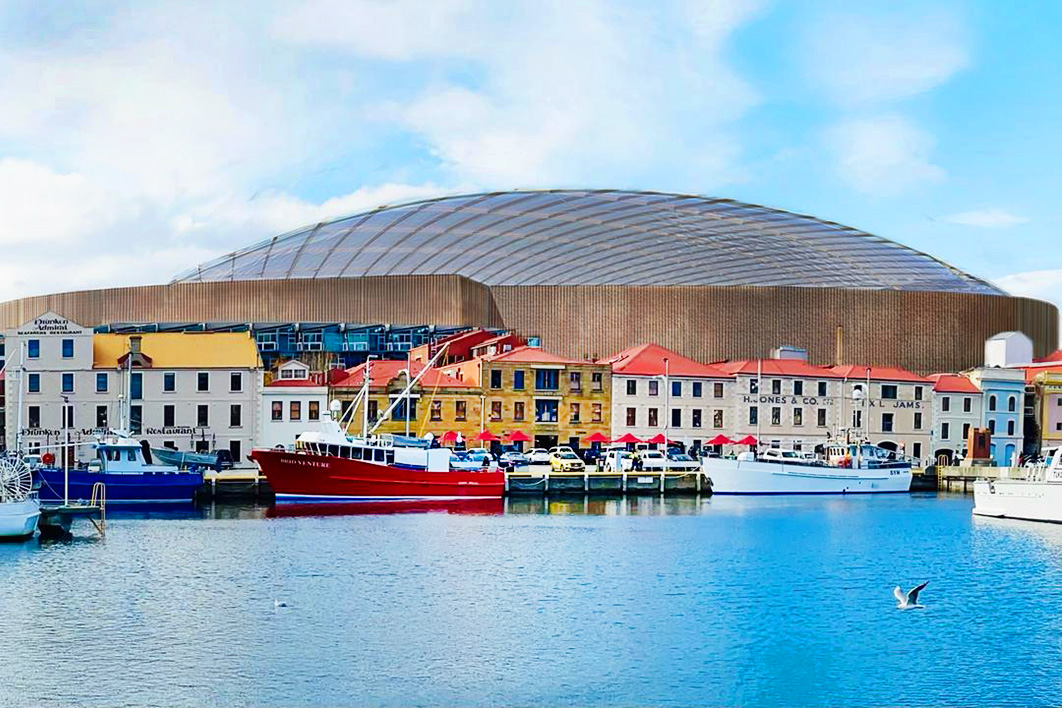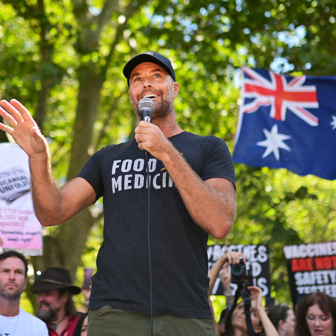A few ordinary games as a defender with the Tasmanian Football League’s Glenorchy club ended any prospect I had of a footballing career. In those days, football was still a celebrated part of Tasmanian culture. The state team’s historic defeat of Victoria in 1963 at Launceston’s York Park was fondly remembered, and the drafting by Melbourne clubs of Glenorchy’s Rodney Eade and other young talents a source of local pride. The original AFL, the Anti-Football League, established in 1967 by Melbourne journalist Keith Dunstan, would surely have attracted very few Tasmanian members.
When Dunstan’s league enjoyed a brief revival in 2007, the Victorian Football League had become a national competition, but the island state — the source of so many footballing greats — was left off the map. Instead, media deals beamed AFL games into Tasmanian homes, the state government guaranteed funding for Melbourne clubs Hawthorn and St Kilda to play home games at York Park and for North Melbourne to play at Hobart’s Bellerive ground, and local footy languished.
Dunstan once boasted that his organisation had more members than the Collingwood Football Club. Now, with uncertainty over an agreement to licence a Tasmanian team if the state underwrites a new stadium in Hobart, Dunstan’s call to “kick the footy habit” and join his AFL might seem to have renewed appeal.
The new Tasmania Devils team, though, boasts a foundation membership of more than 200,000, almost half of the island’s population. I’m one of that number. But three features of the plan — the AFL’s strongarm tactics, the prospect of spending in excess of $1 billion dollars on a venue marginally bigger than the Bellerive oval across the Derwent River from the proposed Macquarie Point site, and the state government’s determination to bypass established planning processes — have alarmed many Tasmanians, football fans or not.
The stadium proposal wasn’t mentioned in Labor opposition leader Dean Winter’s successful no-confidence motion against premier Jeremy Rockliff in Tasmanian parliament last week. Indeed, Labor’s position appears to have shifted, from outright opposition to the stadium under then leader (and now federal member) Rebecca White to support for an alternative stadium plan, at Regatta Point on the Derwent foreshore, under Winter.
Winter cited three reasons for toppling Rockliff: budget mismanagement, plans to privatise state assets, and an inability to deliver major projects. Winter had his sights on the botched procurement of new Bass Strait ferries, currently berthed in Scotland following the discovery that their Devonport wharf requires extension to accommodate them. For many Tasmanians, though, the issues highlighted by Winter crystallise around the stadium.
Opposition has been led by the high-profile No New Stadium group convened by Hobart lawyer Roland Browne. Objections focus on virtually every aspect of the plan: location and design, planning, finance and governance.
Macquarie Point, the site of Hobart’s former railyards and location of Dark Park during MONA’s Dark Mofo festival, is the city’s last available large riverine position. Future development requires significant site remediation, including relocation of an existing sewerage works. The stadium plan squeezes the structure into a corner of the nine-hectare site, bordered on the northern side by Hobart’s main arterial road and on the city side — looking towards Mount Wellington — by the low-rise sandstone warehouses of the Old Wharf, dating from the early 1820s. A good example of adaptive re-use, the Old Wharf precinct offers a glimpse of the mixed-use possibilities No New Stadium and other commentators see as a better pathway for the entire site.
The warehouses of Hobart’s Old Wharf were built where vessels disembarked many of the 67,000 convicts transported to Van Diemen’s Land from Britain, Ireland and other parts of the British Empire. Michael McShane, my third great grandfather, landed there with his brother Hugh in 1818. The few years prior had been especially tough for the two Derry farm labourers and their flax-weaving families. The demand for flax had collapsed with the end of the Napoleonic wars and advances in cotton-loom technology.
More dramatically, though, the northward drift of ash and sulphur clouds from the enormous eruption of Mt Tambora, on the Indonesian island of Sumbawa, had resulted in crop failures, livestock deaths and famine across Europe and North America. Eighteen-sixteen came to be known as the year without summer. The following year, the McShane brothers burgled a house, stealing food and a pistol. Their sentence to hang was commuted, and they were exiled as “lifers” in Van Diemen’s Land.
Such stories illuminate the global historical and cultural significance of this site. But we gain little appreciation of this in stadium planning documents, despite the commissioning of heritage impact assessments. The precinct is overshadowed in every sense by the fifty-four-metre-high stadium. For context, the highest span of Hobart’s Tasman Bridge is forty-six metres. Melbourne’s Marvel Stadium — another AFL-adjacent urban-regeneration project — is thirty-eight metres. Architectural renderings of the structure show how shockingly misplaced and insensitive the proposal is.
Badged as a multi-purpose structure, the stadium would likely involve unquantified cost- and burden-shifting onto the Hobart City Council, which could bear ultimate responsibility for the public safety, traffic management and urban amenity issues that will arise from the stadium’s scale and siting. Like politics, all urban infrastructure is local. The Tasmanian Symphony Orchestra, perhaps Tasmania’s premier cultural organisation, has also been vocal in raising concerns about the siting of such an impactful public venue just 170 metres from the Federation Concert Hall and recording studio.
Objections to the proposed location of the stadium also need to be seen in a statewide context. Tasmanian senator Jacquie Lambie and the new independent member of the Tasmanian lower house, Craig Garland, both from the state’s northwest, have energetically supported locating the Devil’s home ground at the existing facility in Launceston. Might this be seen as yet another example of Tasmanian parochialism? Statewide football has been dogged by regional affiliations. In one famous episode, supporters of the northwest-coast team Wynyard removed goal posts at the end of the 1967 state premiership final to prevent North Hobart’s champion David “Dicky” Collins kicking the winning goal.
But the demographic and economic arguments for Launceston are compelling. Almost two-thirds of the state’s population live outside metropolitan Hobart, and Lambie, especially, has repeatedly drawn attention to the cost and road safety risks of attending live games in the south.
All these concerns about governance and decision-making deficiencies call up a history of corporate interests trumping democratic processes in the state. For many Tasmanians, the AFL now joins the salmon industry, Gunn’s forest industries and the Federal Group gambling and hospitality enterprise as political actors, with this recent private-sector influence overlaying earlier state capture by the Hydro-Electric Commission. The state government’s overriding of established planning processes ignores criticism by the Tasmanian Planning Commission and independent analysis of the state’s finances by economist Saul Eslake, and confirms for many a pattern of cosy relationships. As Lambie characterises it, this was an agreement made over a few frothies.
Since the project was first mooted, the cost of the stadium, and the Tasmanian government’s contribution, have risen significantly. They seem likely to spiral further, fuelled by rising construction costs and design changes. Projections of the state’s budget deficit alarm many, but more tangible evidence of misplaced priorities is evident now in the failing public health system, struggling to service the oldest and poorest population of the Australian states.
Indeed, one alternative use for the Macquarie Point site was a new public hospital, as part of redevelopment plans for the ageing Royal Hobart Hospital in the city centre. Development of affordable housing, too, has been suggested, against the backdrop of Hobart’s severe problem with affordable housing supply. It is more likely, though, that the stadium will be accompanied by high-end residences with a promise of magnificent views over the Derwent estuary.
Speaking after the no-confidence motion was carried by the Speaker’s casting vote, premier Jeremy Rockliff suggested that if you couldn’t build the stadium on what he described as a waste industrial site, you couldn’t build it anywhere. Reflecting on the deal struck for the stadium’s construction, many Tasmanians might flip that statement: if you can build the stadium on this site, you can build anything anywhere. •




